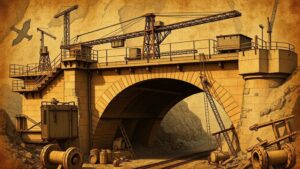Mining Historical Hydroelectric Dam Records for Forgotten Equipment
Mining Historical Hydroelectric Dam Records for Forgotten Equipment
The world of hydroelectric power is often viewed through the lens of modern advancements in technology and sustainable practices. But, the historical records of hydroelectric dams hold a treasure trove of information regarding the equipment and methodologies employed in earlier eras. This research article seeks to explore how mining these historical records can lead to the identification, restoration, and potential reapplication of forgotten hydroelectric equipment. We will examine case studies, methodologies for data collection, and the implications for modern hydroelectric practices.
Historical Context of Hydroelectric Dams
Hydroelectric dams have played a crucial role in electric power generation since the late 19th century. The first significant hydroelectric power plant, the Appleton Edison Light Company in Wisconsin, began operating in 1882. It illuminated buildings and streets, marking the dawn of a new energy era. Over the decades, various dams were constructed across the United States and the world, each employing unique engineering strategies that reflected the technological landscape of their time.
By the 1920s, significant advancements in turbine technology and materials allowed for larger and more efficient dams, such as the Hoover Dam, completed in 1936. Despite their importance, much of the equipment used in earlier hydroelectric infrastructure has been forgotten or rendered obsolete by modern standards.
The Importance of Archival Research
Mining historical records involves the meticulous examination of archival documents, blueprints, maintenance logs, and photographs pertaining to hydroelectric dams. These records can reveal essential information about:
- The types of turbines and generators used
- The construction techniques employed
- Operational efficiencies and inefficiencies
- Maintenance and refurbishment practices
For example, at the Loess Hills Hydroelectric Station in Iowa, records from 1920 reveal that the original Francis turbines were designed for a specific flow rate which was significantly higher than modern designs. Analyzing such records allows for the possible revival of these earlier designs, potentially offering improved efficiencies for current operations.
Case Studies in Equipment Recovery
One notable example of utilizing historical records can be found at the Grand Coulee Dam in Washington State. Built between 1933 and 1942, Grand Coulee has undergone numerous refurbishments. Recent archival research has uncovered blueprints for the original hydraulic systems that predated contemporary turbine installations. By implementing these findings, researchers are currently testing retrofitting techniques based on these historical systems, which could lead to enhanced energy output at low flow periods.
Another example is the Kinzua Dam in Pennsylvania, where examination of older logs documented the performance of vintage generator sets, shedding light on their operational lifespan and suggested maintenance practices. Renewed interest in this equipment has sparked studies on retrofitting legacy equipment to meet modern safety and efficiency standards.
Challenges and Concerns
While the potential benefits of mining historical hydroelectric records are significant, there are intrinsic challenges associated with this practice:
- Data Integrity: Historical records may be incomplete or inaccurate, thereby complicating efforts to reconstruct original designs.
- Technological Compatibility: Merging historical technology with contemporary systems poses engineering challenges and safety concerns.
- Regulatory Hurdles: Modern environmental regulations may hinder the use of older technologies deemed incompatible with current standards.
Methodologies for Effective Data Mining
Effective data mining from historical hydroelectric records encompasses several methodologies:
- Interdisciplinary Collaboration: Engaging historians, engineers, and conservationists to ensure a holistic understanding of historical contexts.
- Digital Archives: Employing digital tools and databases to organize and analyze archived documents efficiently.
- Field Studies: Combining physical inspections of existing structures with theoretical knowledge gleaned from historical documents.
To exemplify this approach, the Electric Power Research Institute (EPRI) has initiated a project blending historical data from the Bonneville Dam records with modern hydraulic modeling. This project aims to optimize future operations while paying homage to historical methodologies.
Conclusion
The historical records associated with hydroelectric dams serve as invaluable resources for reviving forgotten equipment and methodologies that can support current and future energy needs. Successful case studies illustrate that, despite the challenges involved, the integration of historical knowledge with modern technology has immense potential. As renewable energy continues to gain significance globally, tapping into these forgotten records provides both academic and practical avenues for innovation. The objective is not merely the revival of past practices but the enhancement of hydroelectric performance in harmony with modern sustainability initiatives.
Understanding and mining historical hydroelectric dam records is not just a scholarly exercise; it represents a path forward for energy optimization, technological marshalling, and ecological responsibility in the field of hydroelectric power generation.



